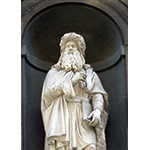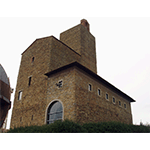Leonardism
The works of Leonardo's followers are not always displayed in Tuscan museums; often, in fact, they are kept in storage (as in the case of the Uffizi Gallery) or in private collections, only rarely put on view. Paintings attributable to Leonardo's pupils or to artists influenced by his style are widespread all over the region, from Florence to Arezzo, from Siena to Pistoia, and as far as Lucca.
Even the testimony of his Spanish followers is found in Florence at the Palatine Gallery and the storage deposits of Palazzo Pitti, and in Arezzo at the Museo Statale d’Arte Medievale e Moderna [State Museum of Medieval and Modern Art].
Ancient and modern works
A Last Supper inspired by the one painted by Leonardo in Milan can be seen, for example, in the church of San Michele at Guamo di Capannori; it is a canvas 283x260 cm in size, dating from 1615.
In painting, the most famous portrait of Leonardo is the one in the Uffizi. It had been considered a Self-portrait, and reproduced as such, since 1715, when Cosimo III brought it to the Gallery; only X-ray examination conducted in the early 20 th century has shown it to be a fake, painted over a seventeenth-century Magdalene.
Also found in the Uffizi, in the set of portraits called Jovian – because commissioned by Cosimo I according to the model of the erudite Paolo Giovio's museum – is a Portrait painted by Cristofano dell’Altissimo around 1566.
A drawing to be seen in relation to the portrait published by Vasari in his Life of Leonardo is found in the Biblioteca Riccardiana [Riccardian Library]: it is the frontispiece of Ms. 3208 ("Discourse on drawing by Leonardo da Vinci"), datable around 1570.
Leonardo has had little fortune as regards commemorative monuments in Tuscany. The most important sculpture is found in the Loggia of the Uffizi, the work of Luigi Pampaloni (1791-1847), dating from around 1839.
In the entrance hall of the Tribune of Galileo at the Museo della Specola, built at the initiative of Grand Duke Leopold II of Lorraine and inaugurated in 1841, among the frescoes dedicated to the scientific knowledge of the time can be seen, on special occasions, the great lunette representing Leonardo before Ludovico il Moro, painted in 1843 by Nicola Cianfanelli (1793-1848); the draft version of this work is found in the Gallery of Modern Art at Palazzo Pitti.
In the Town Hall of Borgo Sansepolcro is a nineteenth-century canvas by Angiolo Tricca (1817-1884), painter and caricaturist, portraying Leonardo as a Boy in Verrocchio's Shop.
Lastly, at the Galleria dell'Accademia, is a painting called Leonardo da Vinci, Old and Mortally Ill, expires in the Arms of Francis I (a canvas of 136x181 cm), with which Cesare Mussini (1804-1879) won first prize at the exhibition of the Accademia fiorentina di Belle Arti [Florentine Academy of Fine Arts] in 1828.
The contemporary scene
In recent decades Leonardo has constituted a recurrent subject for some Tuscan artists who have frequently engaged in dialogue with the genius from Vinci and his work, specialising in individual aspects of the Leonardian idea and iconography, and expressing themselves in a wide range of aesthetic approaches. A list, no matter how brief, must include the names of Marco Bagnoli, Sandro Chia, Adolfo Natalini, Roberto Barni, Andrea Granchi, Lucia Marcucci, Giuliano Ghelli, Franco Bulletti, Sergio Vacchi, Alessandro Reggioli, Antonino Bove, Bernd Kaute, Dilvo Lotti, Vittore Baroni, Franco Fossi, and Andrea Dami; as well as other recently deceased artists: from Vinicio Berti to Antonio Bueno, from Pietro Grossi to Mario Mariotti, from Eugenio Miccini to Beppe Chiari.
Over the years this phenomenon has grown exponentially as regards both creativity and communication, thanks to the diffusion of computerised graphic techniques and Internet.
In Tuscany, from Florence to San Gimignano, from Lucca to Arezzo, public exhibitions with reconstructions and imitations of models are held frequently, confirming the popularity of Leonardo as inventor. Contributing to this success has been the so-called "bicycle of Leonardo", whose design however was lacking from the Codex Atlanticus before its restoration in 1961, as noted by Carlo Pedretti and, moreover, seems not to be by the hand of the master.
An extreme consequence of Leonardo's worldwide fame can be seem in works such as the best selling Leonardo’s Kitchen Notebooks, published for the first time in 1987, which has led many, even the well-educated, to think that Leonardo, in partnership with Botticelli, ran a trattoria in Florence. The clever author even went so far as to describe an imaginary Codex Romanov full of drawings of absurd kitchen implements, menus and recipes concocted by Leonardo.
At Anghiari, in the Palazzo del Marzocco, is a Museum dedicated to the Battle of Anghiari, which displays the works of contemporary artists such as Vittoria Chierici.
At Celle (Santomato, Pistoia) the Gori Collection is known for installations of environmental art in the villa's romantic nineteenth-century park, creating a matchless unicum. Several international artists of the neo-avant-garde, from Robert Morris to Alice Aycock, have worked here since 1982, declaring themselves inspired by Leonardo.
At Seggiano (Grosseto), Daniel Spoerri, an artist of Romanian origin who has lived in France, Switzerland and Germany, is a leading figure in the Nouveau Realisme. He has often engaged in dialogue with the works of Leonardo; and has created on Monte Amiata the "Garden of Daniel Spoerri Hic Terminus Haeret".
Vinci is of course the focal point of attention as regards news of Leonardo. In addition to musical and theatrical events dedicated to him, and to the outdoor works of Mario Ceroli, Nina Akamu and Mimmo Paladino, exhibitions and installations of contemporary artists are frequently held in the Palazzina Uzielli of the Museo Leonardiano, in the Museo Ideale Leonardo Da Vinci and in the Leonardo Garden.
Leonardo's modernity in science and technology
The most fantastic episode of Leonardism in the technological sphere is provided by the work of the Swiss-German symbolist painter Arnold Boecklin (1827-1901), who lived and died at Villa Bellagio in Fiesole and tested his flying machines, extraordinary works of art-science, at the foot of Monte Ceceri.
Various University Institutes, research centres and scientific museums are now studying the relationship of Leonardo, the artist-scientist-engineer, to modern methodologies and knowledge. This is one of the chief goals of the Istituto e Museo di Storia della Scienza [Institute and Museum of the History of Science] of Florence, which organises research projects, workshops, conferences and seminars, publications, on-line education, animation activities, digital archives, and travelling exhibitions, on both the national and the international level.
****************************
Texts by Alessandro Vezzosi, in collaboration with Agnese Sabato
English translation by Catherine Frost
Last update 05/feb/2008





